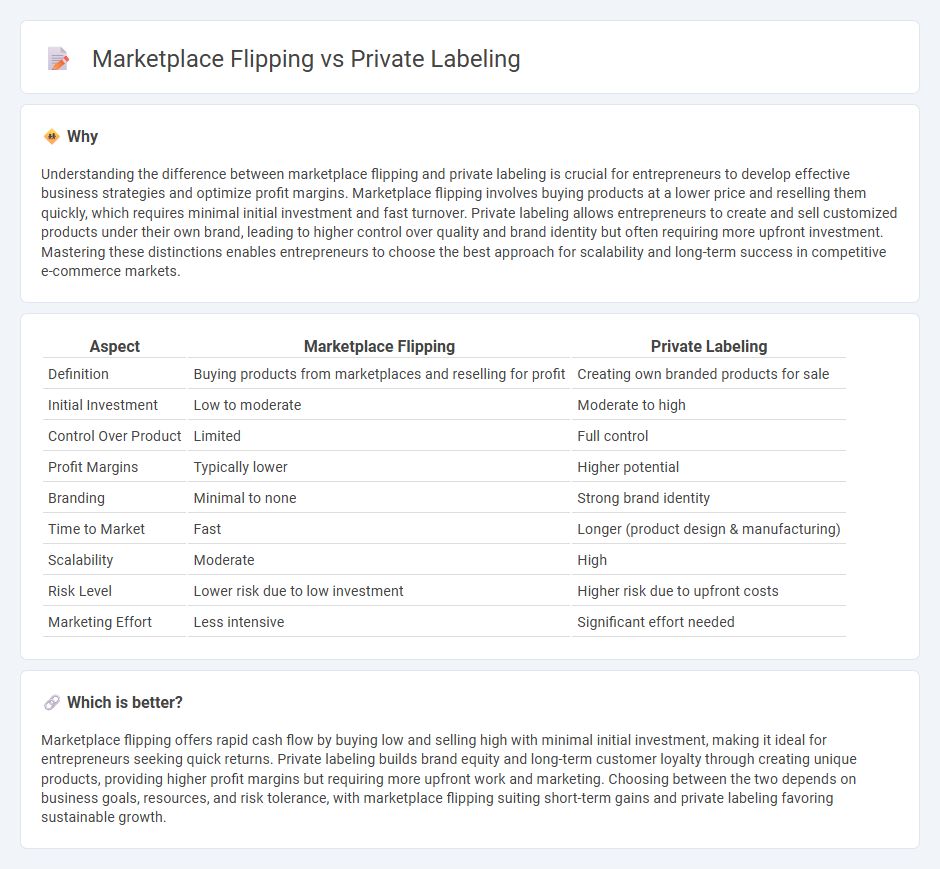
Marketplace flipping involves purchasing products at a lower price and reselling them on platforms like Amazon or eBay for profit, leveraging market demand and pricing strategies. Private labeling, by contrast, focuses on creating a unique brand by sourcing generic products and customizing them with exclusive branding and packaging to differentiate from competitors. Explore these strategies further to discover which entrepreneurial approach suits your business goals best.
Why it is important
Understanding the difference between marketplace flipping and private labeling is crucial for entrepreneurs to develop effective business strategies and optimize profit margins. Marketplace flipping involves buying products at a lower price and reselling them quickly, which requires minimal initial investment and fast turnover. Private labeling allows entrepreneurs to create and sell customized products under their own brand, leading to higher control over quality and brand identity but often requiring more upfront investment. Mastering these distinctions enables entrepreneurs to choose the best approach for scalability and long-term success in competitive e-commerce markets.
Comparison Table
| Aspect | Marketplace Flipping | Private Labeling |
|---|---|---|
| Definition | Buying products from marketplaces and reselling for profit | Creating own branded products for sale |
| Initial Investment | Low to moderate | Moderate to high |
| Control Over Product | Limited | Full control |
| Profit Margins | Typically lower | Higher potential |
| Branding | Minimal to none | Strong brand identity |
| Time to Market | Fast | Longer (product design & manufacturing) |
| Scalability | Moderate | High |
| Risk Level | Lower risk due to low investment | Higher risk due to upfront costs |
| Marketing Effort | Less intensive | Significant effort needed |
Which is better?
Marketplace flipping offers rapid cash flow by buying low and selling high with minimal initial investment, making it ideal for entrepreneurs seeking quick returns. Private labeling builds brand equity and long-term customer loyalty through creating unique products, providing higher profit margins but requiring more upfront work and marketing. Choosing between the two depends on business goals, resources, and risk tolerance, with marketplace flipping suiting short-term gains and private labeling favoring sustainable growth.
Connection
Marketplace flipping and private labeling both leverage product sourcing strategies to maximize profit margins in e-commerce. Marketplace flipping involves buying undervalued products from platforms like eBay or Amazon and reselling them at higher prices, while private labeling focuses on branding generic products with unique labels and packaging for exclusive market appeal. Combining these methods allows entrepreneurs to identify trending items for flipping and subsequently create private label versions, enhancing scalability and brand differentiation.
Key Terms
Branding
Private labeling emphasizes building a unique brand identity by creating customized products that reflect specific values and aesthetics, fostering customer loyalty and long-term recognition. Marketplace flipping involves purchasing existing branded products at a lower price and reselling them for profit, relying on market demand rather than brand development. Explore the advantages and challenges of each strategy to determine the best fit for your business goals in branding.
Inventory Management
Private labeling allows businesses to maintain full control over inventory levels, leading to optimized stock management and reduced risks of overstock or stockouts. Marketplace flipping relies on rapid turnover of purchased products, often facing challenges in predicting inventory demand and managing timely restocking. Explore detailed strategies to master inventory management in both private labeling and marketplace flipping for scalable success.
Profit Margin
Private labeling often yields higher profit margins by allowing sellers to control product quality, branding, and pricing strategies, resulting in better customer loyalty and repeat purchases. Marketplace flipping typically involves lower margins due to competition and fees, but offers quicker turnover and less upfront investment. Explore detailed strategies to maximize profit margins in both approaches for optimal business growth.
Source and External Links
What Is a Private Label? How Private Labels Work in 2025 - Shopify - Private labeling is a business model where a retailer sells products made by a third-party manufacturer under its own brand, allowing exclusive product specifications and marketing while outsourcing production.
Private Labeling vs. White Labeling: What's the Difference? - Indeed - Private labeling involves exclusive products customized and branded by a retailer, offering competitive advantages like price control and brand loyalty compared to white-label, which is generic and sold to multiple retailers.
Private label - Wikipedia - A private label is a brand owned by a company that outsources product manufacturing to third parties but sells the product exclusively under its own brand, distinguishing it from white-label products which are more generic and non-exclusive.
 dowidth.com
dowidth.com